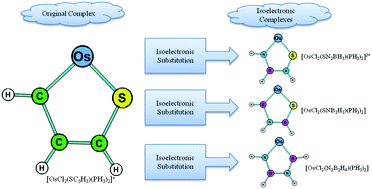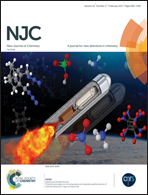Testing the effectiveness of the isoelectronic substitution principle through the transformation of aromatic osmathiophene derivatives into their inorganic analogues†
Abstract
The objective of the current work is to evaluate the effectiveness of the isoelectronic substitution (IS) principle on a series of complexes with the general formula OsCl2(SX3H3)(PH3)2, where X3 represents the moieties CCC, CCB, CCN, CBN, CNB or NCB, formed by substitution of the carbon atoms in CCC by either the isoelectronic B− or N+ separately, or by both. The SX3H3 moiety forms, together with Os, an aromatic five-membered ring (5-MR) called osmathiophene. The preservation of stability and aromaticity in the resulting systems is used to indicate the effectiveness of the IS principle. The aromaticity of the proposed molecules is analyzed according to the magnetic (induced magnetic field (Bind)) and electronic (through the multicenter index (MCI)) criteria. In addition a chemical bonding analysis on selected species is performed by the adaptive natural density partitioning (AdNDP) method.



 Please wait while we load your content...
Please wait while we load your content...